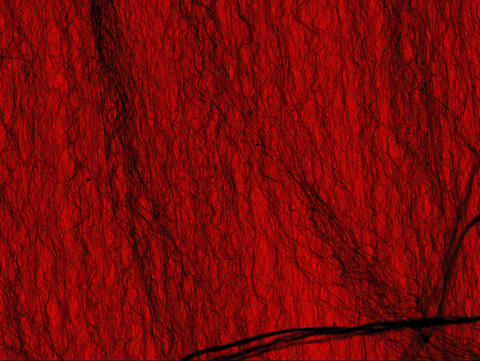
Colorized micrograph of the world's darkest material—a sparse "forest" of fine carbon nanotubes—coating a NIST laser power detector. Image shows a region approximately 25 micrometers across.
Harnessing darkness for practical use, researchers at the National Institute of Standards and Technology (NIST) have developed a laser power detector coated with the world's darkest material—a forest of carbon nanotubes that reflects almost no light across the visible and part of the infrared spectrum.
NIST will use the new ultra-dark detector, described in a new paper in Nano Letters, to make precision laser power measurements for advanced technologies such as optical communications, laser-based manufacturing, solar energy conversion, and industrial and satellite-borne sensors.
Inspired by a 2008 paper by Rensselaer Polytechnic Institute (RPI) on "the darkest man-made material ever,"** the NIST team used a sparse array of fine nanotubes as a coating for a thermal detector, a device used to measure laser power. A co-author at Stony Brook University in New York grew the nanotube coating. The coating absorbs laser light and converts it to heat, which is registered in pyroelectric material (lithium tantalate in this case). The rise in temperature generates a current, which is measured to determine the power of the laser. The blacker the coating, the more efficiently it absorbs light instead of reflecting it, and the more accurate the measurements.
The new NIST detector uniformly reflects less than 0.1 percent of light at wavelengths from deep violet at 400 nanometers (nm) to near infrared at 4 micrometers (μm) and less than 1 percent of light in the infrared spectrum from 4 to 14 μm. The results are similar to those reported for the RPI material and in a 2009 paper by a Japanese group. The NIST work is unique in that the nanotubes were grown on pyroelectric material, whereas the other groups grew them on silicon. NIST researchers plan to extend the calibrated operating range of their device to 50 or even 100 micrometer wavelengths, to perhaps provide a standard for terahertz radiation power.
NIST previously made detector coatings from a variety of materials, including flat nanotube mats. The new coating is a vertical forest of multiwalled nanotubes, each less than 10 nanometers in diameter and about 160 micrometers long. The deep hollows may help trap light, and the random pattern diffuses any reflected light in various directions. Measuring how much light was reflected across a broad spectrum was technically demanding; the NIST team spent hundreds of hours using five different methods to measure the vanishingly low reflectance with adequate precision. Three of the five methods involved comparisons of the nanotube-coated detector to a calibrated standard.
Carbon nanotubes offer ideal properties for thermal detector coatings, in part because they are efficient heat conductors. Nickel phosphorous, for example, reflects less light at some wavelengths, but does not conduct heat as well. The new carbon nanotube materials also are darker than NIST's various Standard Reference Materials for black color developed years ago to calibrate instruments.
J. Lehman, A. Sanders, L. Hanssen, B. Wilthan and J. Zeng. 2010. A Very Black Infrared Detector from Vertically Aligned Carbon Nanotubes and Electric-field Poling of Lithium Tantalate. Nano Letters. Posted online Aug. 3, 2010.
** Z.P. Yang, L. Ci, J.A. Bur, S.Y. Lin and P.M. Ajayan. Experimental observation of an extremely dark material made by a low-density nanotube array. Nano Letters. Vol. 8, No. 2, 446-451.

